


 |
April 9, 2018: Marina Bay and the Downtown Core |
 |
April 7, 2018: Travelling from Seoul to Singapore |
 |
Return to the Index for Our Visit to Singapore |
There is more to do in Singapore than we can possibly cram into a day and a half, but we are going to try. Today, we are going to visit the Marina Bay Sands hotel complex, and visit its rooftop observation platform. Then, we will spend most of the day in the Gardens by the Bay right next door. We have been planning both of these things for quite some time. Our third activity will be the evening light and sound show in the gardens; that show focuses on the Supertree Grove (more on that later). Finally, we have read that there is a light show right by the Bay and we will try to get to see it.
The Marina Bay Sands Hotel and Observation Deck
The Marina Bay Sands is a resort on Marina Bay in Singapore's downtown core. At its opening in 2010, it was billed as the world's most expensive casino property at $6 billion, including the land cost ($900 million all by itself). The resort includes a 2,561-room hotel, a 1,300,000 sq ft convention center, an 800,000 sq ft attached mall, three museums, two large theatres, numerous restaurants, and the world's largest atrium casino. The three separate towers are topped by a 1,120 ft long SkyPark; most of the park, including the 500-foot-long infinity swimming pool, is reserved for hotel guests, but at one end there is a public observation platform with its own restaurants, bars, and, of course, amazing views. All this is set on top of the world's largest public cantilevered platform; it overhangs the north tower by an amazing 220 feet. The resort was designed by Moshe Safdie, the same architect who designed the Habitat we saw last year in Montreal.
Getting to the Marina Bay Sands
|
As we walked through the back streets within our quadrant bounded by major streets, we found that much if not most of the daytime activity was on these small streets; the major ones seemed more sterile, with tall office and residence towers along with large stores, hotels, and other buildings lining those streets. The small shops and restaurants were mostly along the smaller streets, and we found them much more interesting.
|
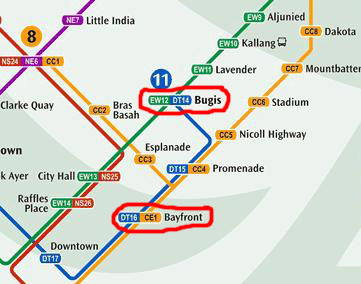
I've marked the two stations that factored in to our travel today; Bugis is the station a few blocks from the Ibis, and Bayfront is the station that is actually underneath the Shoppes at Marina Bay (and this mall is also connected to the hotel, although we didn't know that when we first arrived. The fare for the short ride from Bugis to Bayfront was a very reasonable 60 cents. And it is a short ride; tomorrow, when we do a walkabout Singapore in the morning, we discovered that we could have walked from the Ibis to Bayfront in about 30 minutes. But being as warm and humid as it was, we were happy to ride.
|
We did make a wrong turn as we followed the majority of people who took a set of escalators up to where we thought there might be a connection to the hotel itself. As it turned out, they were all headed to the shopping mall, and once you got up into the mall there was no connection to the hotel itself. That connection turned out be either underground or via an open skybridge (reached by its own elevator on the other side of the mall). But we didn't know any of that, so we went back downstairs and simply went outside to cross the street.
As soon as we got outside, the hotel was right in front of and across the street, so I stopped to take a photo. I couldn't get it all in, we were so close, so I had to take a couple of pictures and stitch them together into the image at right. Right after I finished taking those pictures, Fred called out for me to stand still so he could get his own picture of me and the Marina Bay Sands (which picture turned out pretty well). The other picture that Fred took before we actually entered the hotel was of a beautiful plant that I last recall seeing at the Hawaii Botanical Garden fifteen years ago.
When we crossed the street, we did not notice that there was a main hotel entrance at the end of the tower nearest us, and so we thought that the entrance would be in the middle tower, perhaps on this side. It wasn't, so we ended up walking all the way down to the far side of the third tower. There, we found your typical automobile porte cochere, busy with people coming and going. Heading inside, we saw immediately the signs pointing us to the observation deck. We followed those signs right off, although we could see the vast hotel lobby stretching out in front of us. Since we didn't see much of the hotel right off, I'll postpone showing you our pictures of it and describing it. Let's go right away down the escalator to the ticket kiosk for the observation platform and the separate elevators that service it.
The Marina Bay Sands Observation Platform
|
The three towers are broader at the base and narrow as they rise. Each tower has two asymmetric legs, with a curved eastern leg leaning against the other; the design and construction challenges caused by difficulties with the ground underneath the complex were extensive. Numerous videos can be found online of the construction of the complex; these are pretty amazing and you might want to look for one.
The SkyPark bridges all three towers with a segment cantilevered 200 feet off the north tower (that's where the observation platform is). The hull of the SkyPark was pre-fabricated off-site and then assembled on top of the towers. There are four movement joints beneath the main pools, designed to help them withstand the natural motion of the towers. When you learn that the towers can sway 10 inches in either direction, and when you consider the infinity pool, you can see what a marvel the building is. In addition to wind, the hotel towers are also subject to settlement in the earth over time, so engineers built and installed a custom system that can re-level the pool at more than 500 separate points.
We were not hotel guests, and didn't know anyone who was, so we couldn't wander around the SkyPark. Had we been able to do so, we could have taken our own pictures, but since we couldn't, I've borrowed one from Wikipedia:

Back down in the lower lobby, we've given our tickets to the elevator attendant, and we are on our way up. Arriving at the 60th floor, we stepped out to the south and there, spread out in front of us, were the Gardens by the Bay.
|
That view is actually a composite of three separate pictures that I took; even from this distance (perhaps a thousand feet away) and even with a camera that can take widescreen photos, it was impossible to get it all in. We will be visiting the Gardens when we are done here at the SkyPark and have also seen the inside of the Marina Bay Sands, so I don't need to say a great deal about it now.
But this is an excellent picture for me to use to point out some of the places in the Gardens that we'll visit later today or tonight. At the left you can see two futuristic buildings. These are both gigantic greenhouses- the Flower Dome nearest to us and the Cloud Forest just beyond it. The other major feature is the Supertree Grove right in the middle of the picture- the cluster of purple, tree-like structures. That's also where the light and sound show will be this evening. One other element of note is the bridge in the lower right; the skybridge from the Marina Bay Sands will lead to that bridge into the Gardens. Here are closer views of those elements:
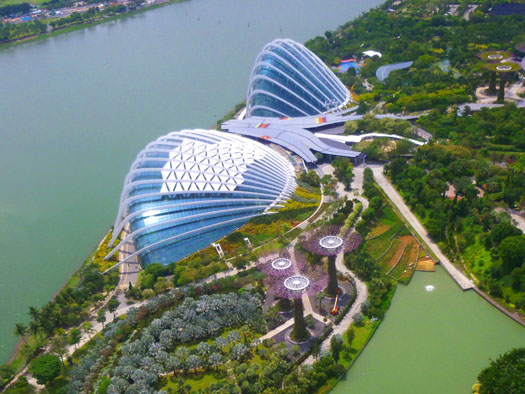 Flower Dome/Cloud Forest |
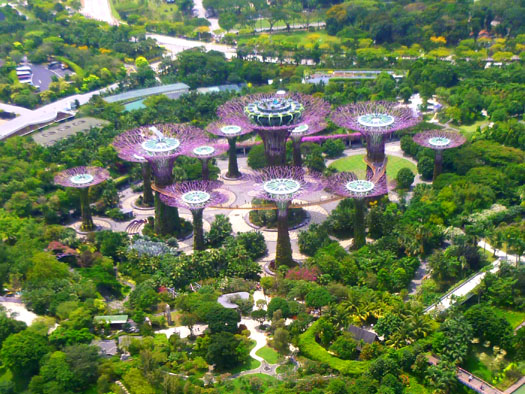 Supertree Grove |
A couple more things before we leave the side of the observation platform that looks out across the Gardens by the Bay. The first is the amazing Supertree Grove. Measuring between 75 and 150 feet tall, these iconic tree-like vertical gardens are designed with large canopies that provide shade in the day and come alive with an exhilarating display of light and sound at night. To show them to you from above, I'll rely on Fred's amazing pictures.
|
 (Click on Thumbnails to View) |
Another interesting aspect of the observation platform is the platform itself. While it's the views from it that are the reason one pays to visit it, it is an engineering marvel on its own.
|
The Marina Bay Sands Observation Platform (Mouseover Image Above for Video Controls) |
I also want to include one more picture of the Gardens by the Bay as it pans up just a bit so you can see the huge number of ships in the harbor just off the coast to the southeast. Singapore is the world's third busiest port, and the world's busiest transshipment port. To see more of how busy the Singapore port actually is, take a look at this view looking southeast past the Gardens by the Bay to see more of the ships waiting to load or unload.
|
I've put an aerial view at left that is expansive enough to show you the various directions that we looked and what we saw in each. As we walk counterclockwise around the horseshoe, we took lots of pictures in all those directions (which meant lots of duplicates to eliminate). But let's move around and look east.
Looking east, we are looking across the artificial lagoon and way out to Changi Airport. I might just point out that the lagoon is mostly artificial; it had been a tidal estuary, but it was dammed up so that the level of water by the downtown core could be controlled (and also so the area could be cleaned out for development. You can see part of the low dam that regulates the lagoon if you look in the lower right corner of the aerial view.
|
At the right, where the waterway meets the straits, is the Marina Barrage- a dam built at the confluence of five rivers, across the Marina Channel where those waterways empty into the sea. It was officially opened in 2008, and created Singapore's 15th reservoir. It provides water storage, flood control and recreation. The S$3 billion project turned Marina Bay into the new downtown freshwater Marina Reservoir. Marina Barrage acts as a tidal barrier to keep seawater out, helping to alleviate flooding in low-lying areas of the city; when it rains heavily, the gates are lowered to release excess water from the reservoir into the sea. By ensuring that the water level in Marina Basin is constant, it allowed all kinds of recreational activities as well as the construction of all kinds of permanent shoreline structures.
|
The stadium features a domed roof structure with a retractable roof and configurable seating on the lowest tier to make it the only stadium in the world that is custom designed to host football, rugby, cricket and athletics events. It is also the worlds largest retractable dome. The lowest tier has mechanized and automated retractable seating configuration ability, so that the stadium can also host concerts and the like (it takes about two days to make the most extreme changes). The stadium holds between 50-55,000 people, depending on the event.
Now we are going to walk down the platform a ways so we can get clear views to the northeast, but before we do, there are a few more pictures I would like to add here.
|
 (Click on Thumbnails to View) |
We walked down to a point near the end of the observation platform, where it curves around the end of the cantilevered portion. Here, we found RON 16X9 LANDSCAPE a restaurant and a snack bar; the restaurant was built above the snack bar, and both were busy. There were lots of people here, looking through the glass and wire. There were so many that I got a bit nervous, knowing I was on a cantilevered platform sixty floors up, with nothing under me. If the "balcony" only stuck out ten or fifteen feet, that would be one thing, but the end of this platform is 200 feet from the north wall of the nearest tower. And when I saw a couple of tons of people clustered at the point of the platform and thought that the contractor had probably gotten the platform built by the low-bidder, well...
|
The Flyer is 541 feet high, and was the world's tallest Ferris wheel until the 550 ft High Roller opened on the Las Vegas Strip in 2014. (The previous record-holder was the Star of Nanchang, in Jiangxi, China, at 525 feet, although that wheel had a diameter ten feet greater than the Flyer.)
Here are two more views looking northeast- one a closer view of the Flyer (left) and one a telephoto picture Fred took of the buildings in the distance:
|
|
Once we moved around to the northwest side of the observation platform we were on the city side, with views out across the artificial lagoon. You can see Fred's picture of me standing by the railing on this side of the platform here. Looking north, one of the first things we saw was The Float.
|
Made entirely of steel, the floating platform on Marina Bay measures about 400 by 300 feet- slightly larger than the soccer field at the new National Stadium. The platform has an incredible capacity; it can hold over a thousand tons- euqivalent to the total weight of 9,000 people, 200 tons of stage props and three 30-ton military vehicles. The gallery on the shore has a seating capacity of 30,000 people.
The floating stadium is a venue for all kinds of events on the waters of Marina Bay- including sports, concerts, exhibitions, and arts and cultural performances. The National Day Parade was held there annually for five years, as a temporary venue during the time that the new National Stadium.
This stadium is part of the Marina Bay Street Circuit Turns 17 and 18 for the Formula One Singapore Grand Prix. Following Singapore's successful bid to host the inaugural 2010 Summer Youth Olympics, the floating stadium was under the spotlight during the Games, as the venue for the Games' opening and closing ceremonies.
|
In 1989, the Singapore Advisory Council on Culture and the Arts produced a report assessing the status of arts in Singapore; that report formed the blueprint for cultural policy in Singapore, and led to the establishment of the National Arts Council and National Heritage Board. The report noted a lack of suitable performance arts venues; the Victoria Theatre could only host medium-size performances, and the Victoria Concert Hall was similarly lacking in its seating capacity and stage size. The report recommended that a new performing arts center be built, and in 1992 an organization was formed to build the Esplanade. Ground was broken in 1996; five years and $800 million later, the center opened.
The design consists of two rounded space frames fitted with triangulated glass elements and sunshades, which balance outward views with solar shading. The original design, presented to the public in 1994, consisted of unadorned glass cases over the theatres, and initially elicited criticisms from the public, many of whom called it "two copulating aardvarks". Critics also accused that the design is insensitive to Singapore's location and climate as it would have created a greenhouse in the tropical climate of Singapore.
The designers countered that some form of shading was always intended, and a cladding of aluminium sunshades was added to the final design. The unique architectural design has been said to have an appearance similar to either a durian (a tropical fruit) or the eyes of a fly. Hence, the building is colloquially known to locals as "the big durians".
|
The architecture is said to be a form reminiscent of a lotus flower; it is another design by Moshe Safdie (the architect of the Marina Bay Sands itself. Referred to as "The Welcoming Hand of Singapore", the ArtScience Museum is anchored by a round base in the middle, with ten extensions referred to as "fingers". The design concept for each finger denotes various gallery spaces sporting skylights at the "fingertips" which are included as sustainable illumination for the curved interior walls.
The ArtScience Museum has 21 gallery spaces with a total area of 50,000 square feet. As with most of Safdie's designs, the building incorporates many sustainability features. Rainwater is harvested and channelled down the center of the building, flowing through its bowl-shaped roof into a reflecting pond at the lowest level of the building. The rainwater is then recycled for use in the building's restrooms. We didn't visit the museum's interior, but would certainly do so on a return trip, as it is always displaying one or more travelling exhibitions from museums around the world.
One structure that we didn't get a good picture of from above was the Helix Bridge, a pedestrian bridge linking Marina Center with Marina South. It was opened in 2010 and is located just west of the two vehicle bridges that connect the same two sections of downtown Singapore- the Bayfront Bridge (southbound) and the Benjamin Sheares Bridge (northbound).
|
To complete our look at the view to the north and northwest from the observation platform, here are some additional views of the bay and the three unique structures at this end of it:
  (Click on Thumbnails to View) |
Now that we have moved around to the western views, I would like to put here a panoramic view of the entirety of Marina Bay. The view extends from the two bridges east of the Helix all the way around 180° to take in the entire downtown core and even part of Bayfront Avenue heading south. Here is that view:

The next two objects of interest are right in the middle of that view, directly across the bay. They are the Merlion Fountain and the Fullerton Hotel; these are on the shore of the bay on the far side at the northeast end of the downtown core.
|
It was originally known as the Fullerton Building, and also as the General Post Office Building. The Fullerton Building was named after Robert Fullerton, the first Governor of the Straits Settlements (1826–1829). Commissioned in 1924 as part of the British colony's centennial celebrations, the building was designed as an office building; a Shanghai firm of architects won the project through an architectural design competition.
In the last days before Britain's surrender to Japan in 1942, the building was used as a hospital, and it was also where General Percival discussed with Governor Sir Shenton Thomas the possibility of surrendering Singapore to the Japanese. During the Japanese Occupation of Singapore, Governor Thomas and his wife sought refuge in the sleeping quarters of the Singapore Club on the building's top floor. Subsequently, Fullerton Building became the headquarters of the Japanese military administration in Singapore.
In 1950s, The Fullerton Building became recognised as the unofficial public monument. It stood out in the city’s skyline as the most prominent feature on the waterfront. On its rooftop stood the lighthouse, whose beacon guided all ships approaching the harbour. In time, The Fullerton became the symbol of Singapore, appearing on every postcard, recognised by traveller and ship captains from all over the world. Singapore was remembered all around the world with the image of The Fullerton Building. Of course, its function as a lighthouse became less and less important as taller and taller buildings were constructed all around it, and stopped entirely in the late 1980s.
|
The Merlion is one of Singapore's most recognizable icons. A mythical creature with the head of a lion and the body of a fish, its body represents Singapore's origin as a fishing village, while its head pays tribure to Singapore's original name, Singapura, meaning "lion city". This icon was designed by Alec Fraser-Brunner for the Singapore Tourism Board, and has been a trademarked symbol since 1966.
I don't want to say much more about the actual fountain just now; we will actually come down to the bayfront to visit it tomorrow morning, and our views will be much better then. But I do want to include a close-up picture and movie that Fred made from the observation platform:
|
Directly across the lagoon from here are not only the Fullerton Hotel and the Merlion, but a number of other important or iconic structures, many of which we will also have a look at tomorrow.
|
Of course you can pick out the Fullerton Hotel and the Merlion again, but you can also see the mouth of the Singapore River and the Esplanade Bridge that crosses it. Note how the river winds around back through the city; this is typical for low-lying areas where small rivers have their outlets to the sea. Right in the center of the picture is the Victoria Theatre, the predecessor of the new Esplanade that we saw a little earlier.
On the far side of the playing field is the National Gallery Singapore, one of the city's largest museums. And behind it is the Singaporean Supreme Court- the building with what looks like a flying saucer sitting on top of it. You can see both those buildings in Fred's closeup view here.
Just to the right of those buildings sits St. Andrews Cathedral. This Anglican cathedral is the country's largest, and is the Cathedral church of the Anglican Diocese of Singapore- the mother church of her 27 parishes and more than 55 congregations. The current church was built in 1856–1861.
To get a better look at the downtown core, we are going to leave the open point of the observation deck, and walk along the north side of the deck; when we did, we passed the stairs up to the restaurant that sits above the snack bar. Those are behind me in Fred's picture of me standing on the open cantilevered area of the observation deck. I used my selfie stick to take a picture of Fred and I with Marina Bay behind and below us, and you can see that picture here. I also have two panoramic views to include. The first is one I made at the end of the platform:

And then when walked a ways down the north side of the observation deck and up a flight of steps to the restaurant level (where we thought we might get better views), Fred made this panorama of the view:

From the upper restaurant level, and also from the lower level and further along the observation platform, we had excellent views of the entire Marina Bay area, and especially of the downtown core and its cluster of new skyscrapers.

Singapore has 30 buildings taller than 700 feet, with floor counts ranging from 50 to 73; almost all of them are in the downtown core shown above. The one thing I noted, even from here, was how sterile that package of skyscrapers seems to be; I couldn't see any little stores and shops at their bases; they looked, for the most part, as if they were all set in a park. Here are some additional interesting views of downtown, taken from the observation deck:
 (Click on Thumbnails to View) |
And I want to include one more panoramic view- one taken from the upper level of the observation deck that shows a 180-degree view all along the northwest side of the Marina Bay Sands complex. It is a good view of the observation deck itself, as well as the view to the north:

From this side of the observation deck, we could see down the curved platform and the SkyPark on top of it. Specifically, using his zoom, Fred could see hotel guests in the infinity pool. In his picture you can see that swimmers can't go to the edge of the pool and look directly down; if that were the case, there would be no place to put a trough to catch water that might slosh over. But even knowing that you couldn't fall directly down, I don't think that I would be able to go right up to the edge.
|
That enable me to get the picture at left. Just looking at the picture makes me a bit nervous, as the camera itself was sixty floors up with nothing below it. (Yes, I wrapped the lasso of the stick around my arm so it couldn't fall.)
We spent some more time here at the westernmost part of the observation deck, admiring the expansive views and taking a good many more pictures. Here are two more good picturs that we took before we went back into the elevators for our return trip to the hotel lobby:
|
|
Inside the Marina Bay Sands Hotel
|
Note, too, that the SkyPark platform doesn't actually sit on the tops of the towers; it is supported by V-shaped supports. Even though there 12 or more of these atop each tower, the pressure on the ones near the edge of each tower must be enormous.
Also in this picture you can see how the glass-roofed atrium lobby connects all three towers. As we found out when we walked through the inside of it, we could see that the atrium was at least ten floors tall.
Finally, you can see the skybridge that connects the hotel to the Gardens by the Bay; the bridge level is accessed via an elevator in the hotel atrium.
Referring to the drone view above, the elevator to the observation deck is in the tower on the right, pretty much at the right side of that tower. On the right side of that tower is the auto entrance for the hotel, as the parking garage is right there as well. But we discovered that, oddly enough, the main hotel lobby is at the base of the tower on the left. You can also see that the elevated walkway from the hotel to the Gardens by the Bay goes through the atrium between the left-hand and middle towers, so we needed to walk down that way to get to it.
|
Also, when you are passing through a tower, there will be restaurants or shops or perhaps a reception desk down on the lobby level.
But when you pass between towers, you find that there are windows on either side. These windows, which continue up to about the tenth floor, are slanted on the Gardens side of the tower, but more vertical on the city side. This is because the sides of the towers, as mentioned above, aren't symmetrical; the southeast half of each tower complex is more curved and more slanted than the northwest half.
As you can also see in a number of the pictures we took is that there are interior bridges between the pairs of towers; I suppose this means that to go from a room in one half of a tower to a room on the other half of that same tower, you can sometimes take a shortcut; although it looks like on the lower floors, it's necessary to go down to the lobby and get a different elevator.
|
|
After taking that picture, I took a picture of the hotel itself, still facing in the same direction as I was in the picture of the two of us. So I am looking northeast and up to see two towers and the SkyPark here at the Marina Bay Sands.
We turned and walked back on the skybridge into the atrium lobby of the hotel, intending to continue on out the other side of the atrium and over into the Gardens by the Bay.
|
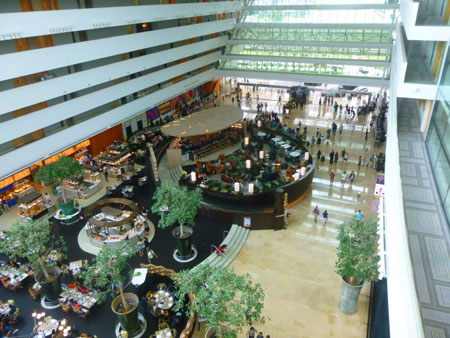
We left the Marina Bay Sands on the skybridge heading southeast into the Gardens by the Bay.
The Gardens by the Bay
The Gardens by the Bay here is a 250-acre nature park all built on reclaimed land. Unlike almost all large gardens that we have been to, this one is an easy walk from the center of downtown, and, consequently, hosts a much larger number of visitors than, say, the Dallas Arboretum, the Missouri Botanical Garden, or Brookfield Gardens in Chicago.
|
Entering the Gardens by the Bay
We walked directly ahead as the skybridge crossed over Sheares Avenue, and ahead of us we could see the Supertree Grove (which we will visit later). Fred also took a closeup picture of the Grove, and in it you can easily see the people on the Supertree Skywalk.
|
We did take the escalators down and followed the signs (and the people) to a walkway over a canal with fountains that forms the northwestern boundary of the Gardens. (Being one of the popular tourist attractions in Singapore, the park receives some 7 million visitors a year.) The canal continued to the southwest, and here are a couple of views in that direction, taken from the bridge over it:
 (Click on Thumbnails to View) |
As we walked over the bridge, I looked back once again and found that I could finally get the entirety of the Marina Bay Sands in a single image, and so I tried two or three angles with the best one having been included here.
|
|
I was definitely looking forward to getting up onto the skyway in the Grove; even from down here on the ground it looked like an amazing experience. (We also plan on returning here after dark for the light and music show here in the Grove.)
But we continued along a beautiful garden pathway that we could see was heading directly to the conservatories. Presently, we arrived there and got into the long (but quick moving) ticket line. We bought a day pass to all three of the major attractions, got something to drink, and then headed first into the smaller (but taller) of the two conservatories- the Cloud Forest.
The Cloud Forest Conservatory
The Cloud Forest Conservatory covers just about 2 acres (about as big as a football field, including sidelines and end zones). The conservatory encloses about 1.5 million cubic feet (the volume enclosed by approximately 60 Olympic-sized swimming pools). The surface area of the glass dome is a bit more than 100,000 square feet, and this area is covered by 2,500 glass panels of almost 700 different shapes and sizes. The interior volume is kept at a temperature of between 73-77°F and 80-90% humidity.
|
Entering through those doors we found ourselves in a cool, humid world veiled in mist; the Cloud Forest Conservatory is constructed around its central feature- a 100-foot-tall indoor mountain covered on all sides with lush vegetation. And on the side of the mountain you are facing when you enter (from the left in the diagram shown at the left) is the world’s tallest indoor waterfall. The sound and mist kind of hit you between the eyes; and your eyes are drawn inexorably up to the peak of the gigantic indoor mountain.
Near the entry is where I found this diagram on a plaque (although my picture of it didn't turn out well, and so the copy used here is from the Gardens by the Bay website). We are going to follow the route indicated on that plaque. It will take us around the far side of the mountain (behind the diagram) and up a series of inclines to a set of elevators. These will take us to the very top- the Lost World. From there, we will follow what will be essentially a single winding path down and around and through the mountain until we arrive back here. To organize the pictures from the Cloud Forest, I'll divide them into sections keyed to the diagram- beginning with the first two sections: The Falls and The Incline.
Entry and The Falls
|
|
As you can see (and hear) the waterfalls were pretty amazing- all th emore so because they were inside a structure rather than outside in a jungle or a forest.
|
Moving closer to the falls around to the left, we could look up to see the waterfall view platform, and we assumed that our walk down would include a stop there. Also, close to the falls on the left there was a display or orchids and other tropical plants.
We took many other pictures before starting up the incline; here are a few of them:
 (Click on Thumbnails to View) |
Getting to the elevator bank around the back of the mountain took us up a long, curved, switchbacked incline, and there was a lot to see along it.
The Walk Up to the Elevators
|
Here are the rest of the sculptures or fanciful figures that we saw on our way up the incline:

(Click on Thumbnails to View) |
Walking up to the elevators took half an hour- there were so many interesting plants to have a look at. There were also quite a few times- particularly when we got around to the other side of the mountain- that we could see some of the walkways above us that we would be walking along when we descended. At the top of the incline, we came to an open area where, when there are great numbers of people going through the conservatory, they have crowd control barriers to queue people up for the elevators. Today, though, these were not in use.
|
Below are some of the views that we had looking up at the cantilevered skywalks that emerge from and reenter the central mountain here in the conservatory. I'm looking forward to getting up there:
 (Click on Thumbnails to View) |
So, we've reached the entry to the elevator lobby, and we can see the top of the mountain looming above us. Before we head into the elevator though, let's see some of the beautiful plants that we passed on the way up.
|
The Lost World
|
 (Click on Thumbnails to View) |
And then we walked out into the brightly-lit open area. The centerpiece was a small lagoon, and there also seemed to be either a permanent or temporary exhibition of some of the plants and flowers recreated with Lego™ bricks; we've seen the same thing in other gardens before.
In this cool, moist climate, the focus was on carnivorous plants, ferns, and mosses that were thriving to the accompaniment of the sounds of the cascading waterfall, which was being fed by the pool at this level. One of the signs told us that "the higher you go, the shorter the trees and shrubs, the smaller and thicker the leaves, the mossier every surface, branch, and twig on every tree is, the greater the number of plants that perch on high, and the more restricted and rare the species".
|
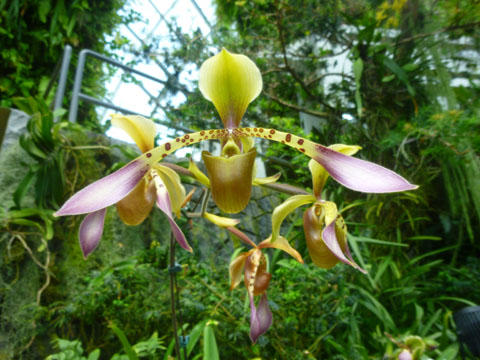
We found out later that the Cloud Forest Conservatory features some 130,000 plants that are found in high-altitude tropical zones- such as the mountain regions of tropical Africa and South America. This seems like an amazing number, but I doubt the Gardens would put it on a sign if it weren't true.
|
|
The Cloud Walk
|
Right at the beginning of the walk, we could look out through the glass panels in all directions, and Fred took pictures of the Marina Bay Sands and the Supertree Grove. Those pictures are below (including an incredible closeup of the Observation Deck atop the Marina Bay Sands hotel):
 (Click on Thumbnails to View) |
So we started out on the slowly descending walkway, which was really one of the neatest things we've seen in any botanical garden or conservatory. First of all, from this high up, we had great views of the entire Conservatory, including views down to where we had been. One of those views was down to the queue at the elevators, which was still not crowded (although it seemed that they had opened a small part of the queue to funnel people to the elevators). Another neat view was back down to the base of The Falls. Actually, as I walked a short ways down the Cloud Walk, I got another good view looking at the walkway three floors down.
|
We took quite a few really good pictures along the walkway, all the way to the entrance to The Cavern; here are some of them:
  (Click on Thumbnails to View) |
Crystal Mountain (The Cavern and Waterfall View)
|
(Mouseover Image Above for Video Controls) |
Treetop Walk
|
|
There were also neat views looking down to the people milling about near the top of the incline walk, near the crowd-control devices and the elevator we took up. Here are three more good pictures we took along the Treetop Walk:
 (Click on Thumbnails to View) |
The Secret Garden
|
Here are more pictures from the Secret Garden:
 (Click on Thumbnails to View) |
I might mention that a wall plaque credited the development of the Secret Garden to Mr. Tan Jiew Hoe, President of the Singapore Gardening Society. He worked closely with Gardens by the Bay over two years to transform the landscape of the Secret Garden, and has said:
| "For the new Secret Garden, we chose plants that can be found in the special environment of limestone forests and caves. In time to come, we hope to slowly introduce species that are either endangered or close to extinction, and nurture a refugium for plants." |
When we exited the Secret Garden, we followed the path through a corridor that eventually put us back on the plaza below the Waterfall. We took a few more pictures there, and then left the Conservatory. Since we were cooled off from being inside, we decided to visit the Supertree Grove before the Flower Dome.
The Supertree Grove
|
|
Here, the term is honored in that sense because we found out that plants used in the framework for each tree are representational of the relationships those plants have in their kingdom; each tree is (as much as the climate here will allow) composed of plant species and examples that are related.
Here in the Gardens by the Bay, the Supertrees are home to "plant enclaves", such as unique and exotic ferns, various kinds of vines, many varieties of orchids, and also a vast collection of bromeliads such as Tillandsia, amongst other plants.
|
If you look towards the bottom of the trees, you will see that various plants and vines are intertwined with the framework. When the trees were constructed in 2011, they were bare frameworks. The flora was planted at that time, and in the past seven years has grown significantly, covering about half the framework. Eventually, it is expected, the plants will find their way up to the tops of the trees, and there are plans to add soil containers and more plants further up the trees, as few vines are going to be able to sustain a 100-foot climb (although they might want to try kudzu on one of the trees). I think they are waiting until the plant growth is sufficient to hide such containers.
The trees are not just giant trellises, though. They are fitted with environmental technologies that actually mimic the ecological functions of trees. For example, the trees have photovoltaic cells that harness solar energy which can be used for some of the functions of the Supertrees themselves (such as the nighttime lighting); this is just how real trees photosynthesize. The trees also have systems for the collection of rainwater for use in irrigation and fountain displays; again, this mimics exactly the way real trees absorb rainwater for growth. The Supertrees also serve air intake and exhaust functions as part of the conservatories' cooling systems.
From up on the skyway, I took a picture of one of the smaller trees, and it is a good example of what each of the trees looks like after being here for some years now. One of the larger trees also has an observatory and restaurant at its top.
|
This elevated walkway can be reached via an elevator in one of the large trees, and you exit from the walkway via the elevator in another one. The largest (160 foot high) tree has a- the one with the food and beverage outlet at the top.
Each evening, at 7:45pm and 8:45pm, the Supertree Grove comes alive with a coordinated light and music show known as the Garden Rhapsody. The accompanying music to the show changes every month or so, with certain themes such as A World of Wonder and A Night of Musical Theatre, which features excerpts/pieces from films like Jurassic Park and Pirates of the Caribbean. We will be coming back to the gardens this evening for one of these performances.
So, what was walking on the Skyway like? Well, as you have seen in many of the pictures already, it is a long, curving walkway that starts at one of the larger trees and ends at another large one. My guess is that it is perhaps a quarter mile long. They try to have you walk it in one direction, but people are often milling around or going back and forth. My guess is that the walkway is 4 or so feet wide at its narrowest.
|
|
The pictures above are representative of what the views were like from the Skyway; one looks back towards the starting tree, and the other was taken close to the ending tree. I also made a couple of movies, but I have to say that it was so windy up here on the Skyway that given the choice between my narrative plus wind noise or no narrative and no wind noise, I opted for the latter and have taken the sound out:
As I said, and as you can see from the movies, the walkway got fairly narrow towards the middle. It was entirely supported by the anchors at the large trees and a series of many support wires anchored by the trees that it passed nearby. (Sadly, these support wires got in the way of a good many pictures.) Even so, we took a good many pictures. Below, left, is a good one of the Marina Bay Sands, and to the right is a slideshow of the other pictures we took worth including here. (As with all slide shows, use the lower-corner arrows go from one picture to another. Index numbers are in the upper left.)
|
I also made one panoramic picture. It's OK, but would have been much better had the day not been so cloudy. In any event, here it is:
 |
When we got to the ending Supertree, we took the elevator down and then retraced our earlier path back towards the two conservatories, this time to take a tour through the Flower Dome.
The Flower Dome
Entering the Flower Dome Greenhouse
Immediately inside, both Fred and I took almost identical panoramic views looking to the Succulent Garden and The Baobabs to our right, and the entrance to the Flower Field (an Oriental garden) through the Torii Gate to our left. Here is one of those views:
 |
Fred also took an interesting picture looking up at the glass panels comprising the ceiling; each one seemed to be of a slightly different shape or curvature:
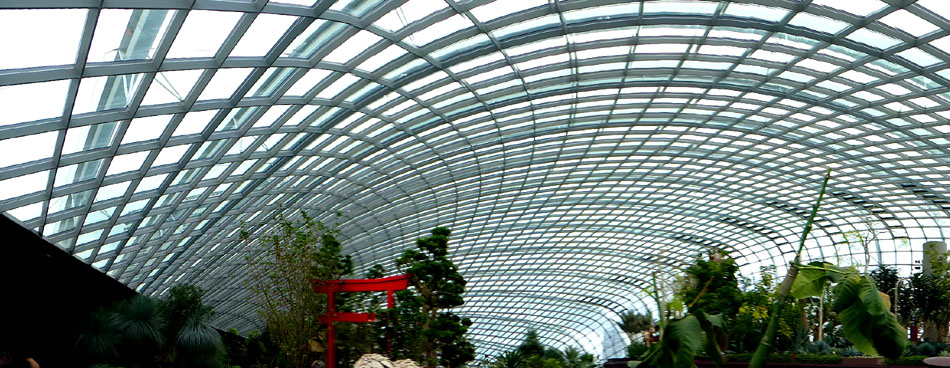 |
We didn't take an incredible number of pictures here in the Flower Dome; we were more interested in just looking at the different plants in the different themed areas; actually, most of our pictures were of the greenhouse itself, the people wandering through, or the various sculptures and displays that we saw.
|
At left is a diagram of the Flower Dome, and the "themed" areas are marked on it. We'll visit most of them, and I will try to describe each of them in its own little section.
First, we turned to our right to see the Succulent Garden and The Baobabs.
The Succulent Garden
|
A dense cover of blue or grey wax over the surface of their leaves and stems also helps protect them from dehydration and deflect excess UV light in the desert. One example is the Maguey from Mexico and Central America. The Maguey is monocarpic, which means that it flowers once and then dies.
Some species of succulents have spines to protect their juicy leaves from predators, and some are a food source; in Mexico, the Blue Agave plant is harvested for tequila, which is distilled from its fermented sap.
Not for the last time here in the Flower Dome, we ran across some interesting or fanciful sculptures scattered among the plants. Here, we seem to have a a woman under a toadstool; she looked like a fairy tale figure.
Fred likes succulents, and so he took quite a few pictures. Here are some of them:
|
The Baobabs (and Bottle Trees)
|
Also behind me you can see a tree that looks as if it is dead; there are no leaves to speak of. This is the Ghost Tree, which originated in Southwestern Madagascar, is often cultivated at traditional tombs in local villages. Despite being related to the edible Horse Radish Tree from India, its foliage, fruits and seeds are not consumed locally. Some cultures claim to use its aromatic sap as medicine for coughs and colds.
Here, too, we found some interesting sculptures, and these all seemed to have an African theme (not unexpected). The last time I recall seeing a baobab was at Fairchild Gardens in Miami, and I think their specimen was about the size of these.
|
Another interesting tree we saw (and which appears in the photos here) is the Drunken Tree. It's seeds are surrounded by smooth, light fibers that are usually collected to make pillows and cushions. They have unique round trunks that are used to store water, and beautiful ivory-colored flowers that are pollinated by hawk moths.
Here are three more good pictures from Baobabs and Bottle Trees:
|
Other Gardens in the Flower Dome
|
|
As for the candid photos we took, I have just put them into a slideshow, and that slideshow is at right. I hope you enjoy the best of the many pictures we took in this amazing greenhouse. To move from one picture to another, use the arrows in the lower corners of each one; track your progress with the index numbers in the upper left.
I also have four more good pictures that Fred took, and I want to include them here also:
|
To finish up our visit to the Flower Dome, I want to include one of the many panoramic shots we tried. The glare through all the glass was tough to deal with, and spoiled quite a few pictures, but here is one that will give you an idea of the expanse of the greenhouse:
 |
It was late in the afternoon, so we decided to head on back to the Ibis, relax for a while, and then return for the evening sound and light show at the Supertree Grove.
Returning to the Ibis
|
|
Eventually, we found ourselves back at the escalators up to the bridge that takes you back into the Marina Bay Sands hotel, so we crossed that bridge and went all the way through the hotel and out the other side to cross over Bayshore St. On the open air bridge over the street, I stopped to take a picture of the Sands and The Singapore Flyer. Then we were on the other side of the street, and we followed the other people over to an entrance to the Shoppes at Marina Bay.
This entrance brought us in to the mall on its top level (a level that didn't have any stores or views down into the mall itself. There were two long escalators that took us down into the mall itself which was, to put it succinctly, amazing.
|
|
(Mouseover Image Above for Video Controls) |
I took a couple of other good pictures here inside the Shoppes at Marina Bay as we were making our way through the mall and back down to the underground metro station. You can see a view down into the mall and also a view looking towards the entrance to the Convention Center and the Metro entrance; that view shows the windows looking out at the hotel. We found our way back to the Metro, got tickets, and maybe twenty minutes later were coming up near the Ibis Hotel at the Bugis station. Then, we retraced the same path we'd followed this morning to get back to the hotel. Here are two views of the small streets that we took to get back to the hotel:
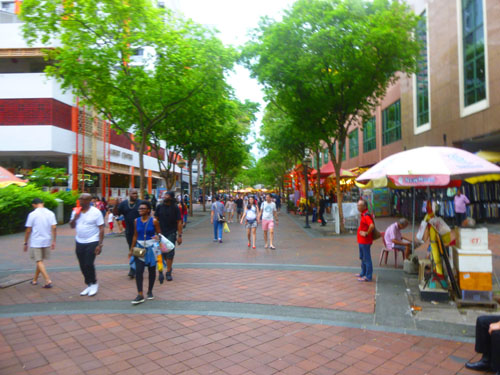 Typical Neighborhood Street |
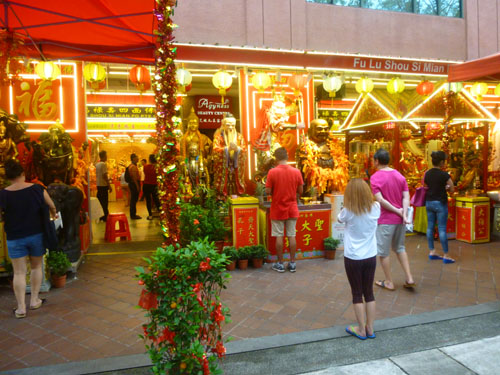 "Prayers-r-Us"? |
We were able to relax in the room for a while, working on our email update from Seoul, and then about 645PM headed back out to see the evening show in the Gardens.
The Evening Show at the Supertrees in the Gardens by the Bay
By this time we were quite used to the Metro, so we bought a return ticket to save ten cents to get down to the Marina Bay Sands. We were also kind of knowledgeable about getting around the Shoppes and the Hotel and over to the Gardens by the Bay, and so had no problem getting into the gardens. Crossing the skybridge from the Hotel into the Gardens, we got to see them at night for the first time:
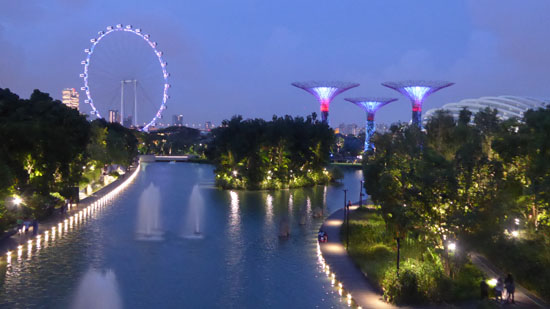 Canal and the Flyer |
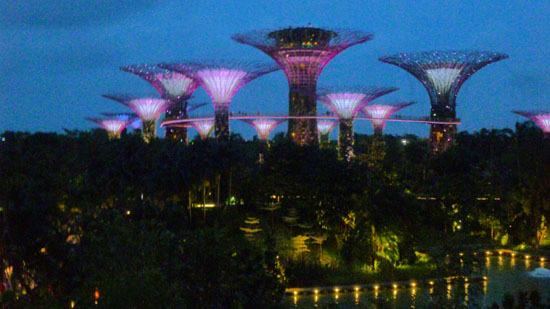 The Supertree Grove |
We wanted to be in place for the 7:45 show, but misjudged what the crowds would be like, so by the time we got to the Supertree Grove, the sound and light show was just starting. It took a few minutes for us to find a place where we could sit down and watch the show; all the benches were already taken, of course, but we did find some space near the base of one of the towers. We also wandered around a bit during the show taking pictures of the various lit-up trees. Let's begin with a couple of Fred's movies:
|
|
|
Of course we took pictures, too. With the crowds jostling around, and no places to set up a tripod, our pictures weren't always the clearest, and so I've deleted about half of them. But many remain to show the incredible colors and lighting effects that have been built into the trees.
|
|
|
At right is the slideshow with the best of Fred's pictures. As usual, use the little arrows in the lower corners to move through the show, and track your progress with the index numbers in the upper left. Enjoy!
As for my pictures and movies, I experienced rather more focus issues than Fred, but still I came away with a few good pictures of the show here in the Supertree Grove.
|
|
(Mouseover Image Above for Video Controls) |
|
The sound and light show lasted for about 45 minutes; there are usually two each night, and I suppose the intermission is to allow folks to change out between shows (although I saw quite a few people just keeping their seats). We, however, wanted to go over to Marina Bay as we'd found out there was another light show that would be on this evening.
The Spectra Light and Water Show
Spectra is a free-to-public outdoor light and water show displayed over the water at the Event Plaza along the promenade on the southeast side of Marina Bay. The show tells a story, and it unfolds in a symphony of music, water and light that's powered by advanced lasers, fountain jets and visual projectors.
|
|
To really watch the show properly, you need to be right down by the shore of the Bay; even better are the views from the other side of it, by the Merlion fountain. We did not have time to get to either place, so what we did was just take the skybridge over Bayshore and onto the rooftop of the Shoppes, and then we walked at that same level over to a promenade that lines that huge building and offers views of the Bay and of the Marina Bay Sands behind you. It may be a little hard to explain, or see in the aerial view above, but the walkway we ended up on actually runs along the bay side of the skylighted roof of one section of the mall. Between us and the bay was an arched roof over the mall itself. The walkway goes all the way down towards the Helix bridge.
As soon as we arrived here (and there were a fair number of other people as well), we found a seat on the bleacher-like concrete benches lining the walkway (they were only three levels high). Spread out in front of us was the downtown core of Singapore:

We were not actually sure that we would get to see the show very well from here, but since there wasn't time to get to any place better (we could already hear the music starting up), we stayed where we were. As it turned out, while we didn't get the full effect of the lasers playing on the water mist, it was good enough to get the idea and enjoy the show.
|
Lasers positioned in front of the mist wall then project images on that mist curtain, which acts as a reflective surface allowing fairly detailed images to be projected. We did not know what the images were- I think they were intended to be viewed from across the bay- nor did we know what story was being told. We just admired the technology that made the show possible.
|
Watching the show with the skyline of Singapore in the background was pretty amazing, but I am sure that watching it from the other side, with the Marina Bay Sands looming in the background would have been just as neat.
We were a little far away for movies, and there were some roofs and other obstructions in our way, but we did take a couple that are worth watching:
|
(Mouseover Image Above for Video Controls) |
(Mouseover Image Above for Video Controls) |
When the show was over, we left the outdoor walkway and went back down to the entry into the mall- the same one we'd used earlier in the day. The mall is open very late, and we were hungry, so we did indeed find the food court and something to eat (fast food, if you must know, but a local restaurant at least). We took the opportunity after dinner to walk around the mall a bit more, and I came away with two more good pictures of the interior of this particular temple of consumerism:
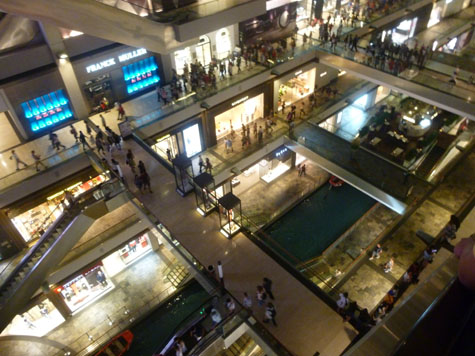 |
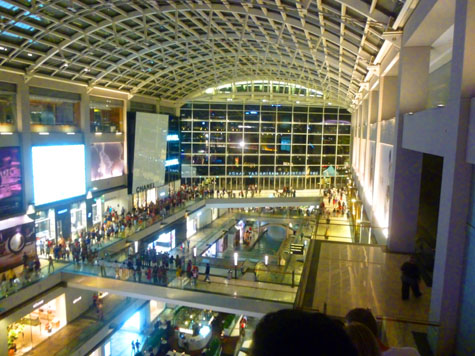 |
Then is was back down to the Metro, which seemed even busier than it had been earlier in the day (we think that Singapore is very much a late-night city, and I suspect that the Sands Casino is open 24 hours and it can be entered from inside the mall). We caught our quite full train back to Bugis Station and the short walk back to the Ibis.
Our cruise boards tomorrow, but we are going to visit the other side of Marina Bay in the morning and, we hope, get up close and personal with the Merlion fountain.
You can use the links below to continue to another photo album page.
 |
April 9, 2018: Marina Bay and the Downtown Core |
 |
April 7, 2018: Travelling from Seoul to Singapore |
 |
Return to the Index for Our Visit to Singapore |